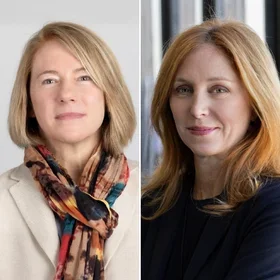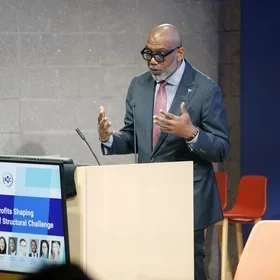By Steven Cohen, Ph.D., Director of the M.S. in Sustainability Management program, School of Professional Studies
When I was a teenager, I used to ride my bike on a path along the Belt Parkway in Brooklyn, and off in the distance, I could see the Fountain Avenue and Pennsylvania Avenue Landfills rising to the sky. We called it the Brooklyn Alps and wondered if it could disrupt air navigation into Kennedy airport. I think watching that landfill grow until it was forced to close may have been the spark that lit my interest in waste management. I’ve been heavily into garbage ever since. Ultimately, I believe we will need to use robotics and artificial intelligence to mine our waste stream for resources. Over the coming decades, the price of mining the planet for resources will continue to grow along with the costs of transporting and dumping waste. The “tipping fees” at landfills continue to increase as land becomes more expensive. Mining and waste management damage our ecosystems and those “externalities” can also be quite costly. However, in the decades before automated waste mining technology becomes cost-effective, we have a clear opportunity to both reduce and recycle food waste. While recycling has a high failure rate, we seem to do better recycling food waste than recycling other substances. In addition to ensuring food waste is properly recycled, we need to do a better job of “rescuing” food from ever becoming waste to feed people in need. I remember looking at that growing mountain of garbage accumulating in Brooklyn and wondering if any of the stuff dumped there could have been used.
Even the U.S. federal government has begun to recognize the opportunity presented by food waste. Last week, it announced a strategy on food waste that will be implemented by the Environmental Protection Agency, the Food and Drug Administration, and the Department of Agriculture. According to an EPA press release:
“…the U.S. Environmental Protection Agency, the U.S. Department of Agriculture and the U.S. Food and Drug Administration, announced the “National Strategy for Reducing Food Loss and Waste and Recycling Organics” as part of President Biden’s whole-of-government approach to tackle climate change, feed people, address environmental justice, and promote a circular economy. The strategy released today provides tangible goals that the U.S. government partners along with retailers and consumers can work toward to help further prevent the loss and waste of food, increase recycling of food and other organic materials to support a more circular economy for all, reduce greenhouse gas emissions, save households and businesses money, and build cleaner, healthier communities…. The strategy highlights four objectives: Objective 1: Prevent food loss. Objective 2: Prevent food waste. Objective 3: Increase the recycling rate for all organic waste. Objective 4: Support policies that incentivize and encourage the prevention of food loss and waste and organics recycling.”
Part of the issue is that in our fast-paced and largely wealthy nation, we throw out a lot of food we or someone less fortunate could eat. This is, in some respects, a cultural phenomenon. In a society with less wealth, whatever is edible gets eaten: every piece of meat or poultry and every part of a vegetable is used in stews or soups, and nothing is discarded. Meals are not super-sized, and food that is not eaten is saved for later meals. The amount of food we discard in the United States is staggering. Last week, in a New York Times piece on the National Food Waste Strategy, Somini Sengupta reported that:
“Roughly 30 percent of the country’s food supply isn’t eaten, but thrown away or otherwise wasted. In fact, food is the single largest volume of material sent to landfills and incinerators in the United States. When uneaten food goes into landfills, it breaks down and produces as much greenhouse gas emissions annually as dozens of coal-burning power plants, according to the federal government. The White House strategy involves efforts to change the behavior of both businesses and individuals to reduce waste, as well as to fund research into extending the shelf life of perishable foods, expand food donations and turn food waste into usable commodities like compost, gas or animal feed.”
Here in New York City, we have been working on recycling food waste for over a decade. We’ve also been trying to rescue food for over forty years. It’s a topic closely related to the development of an urban circular economy. Since 2013, large commercial ventures in New York City have been required to separate and recycle their food waste. Since commercial waste disposal is not provided by the New York City Sanitation Department, most of the food waste is recycled by private carting and disposal firms under contract to restaurants and other food-related businesses. If a food business has the capacity, they are permitted to recycle food waste themselves and can even recycle food on-site. Businesses can also donate food that is still fresh enough to be eaten. Over the past year or so, the Department of Sanitation has begun to implement residential food waste recycling. Curbside pick-up is now available in Brooklyn, Queens, and parts of Manhattan and the Bronx. It is scheduled to begin city-wide in October of 2024 and will become mandatory for households in the spring of 2025.
The irony of discarded food is that we are throwing out food that could feed hungry people in our own community. In New York City, we have several large nonprofit organizations that “rescue” food and deliver it to people who are food insecure. One of these organizations is the New York Common Pantry (NYCP). According to their website:
“NYCP’s food rescue program accepts and picks up perfectly good food from a growing number of restaurants, caterers, food markets, supermarkets and events that would otherwise be thrown away. This food helps NYCP with the more than 8 million meals it distributes annually to the over 2 million New Yorkers that are food insecure… NYCP’s food rescue program minimizes food waste AND food insecurity by distributing the food to hungry New Yorkers through our Hot Meals, Choice Pantry, Mobile Pantry and Brown Bag programs.”
City Harvest is another large nonprofit that runs a food rescue program and has even refined it to provide food to food-insecure kosher and halal-observant communities. According to their website, since their founding over forty years ago, they have “rescued” more than one billion pounds of surplus food. Estimates of food insecurity in New York City vary, but according to Community Service Society President and CEO David Jones, “Almost a third of the city often goes to bed hungry.” In a city as wealthy as New York, this hunger in the face of plenty is an ethical nightmare. We simply can and must do better.
The issue of food waste is multi-dimensional. First, there is the issue of the full utilization of food to feed people who are hungry. Second is the issue of preparing food in such a way that none of it is discarded in preparation. Third is the issue of recycling food waste to create revenue-generating biogas and fertilizer rather than producing greenhouse gasses and other pollutants when dumped in a landfill. Sustainability management requires careful consideration of each dimension of the food waste issue. We should strive to reduce the amount of waste, rescue food that would otherwise be discarded when possible, and finally, divert food waste from landfills. We know how to do all of this; we simply need the will and organizational capacity to get it done. Food waste and food insecurity are both environmental and ethical issues. We have a deep moral obligation to feed every hungry child in the world. For hunger to persist in a place as wealthy as New York City is a massive failure of public policy and community. Ignoring this issue is profoundly unethical.
Views and opinions expressed here are those of the authors, and do not necessarily reflect the official position of Columbia School of Professional Studies or Columbia University.
About the Program
The Columbia University M.S. in Sustainability Management program offered by the School of Professional Studies in partnership with the Climate School provides students cutting-edge policy and management tools they can use to help public and private organizations and governments address environmental impacts and risks, pollution control, and remediation to achieve sustainability. The program is customized for working professionals and is offered as both a full- and part-time course of study.



